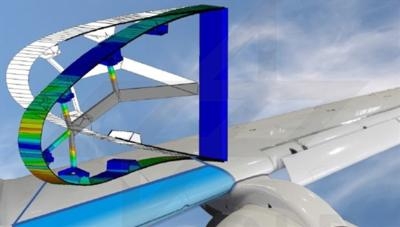Mon, Sep 10, 2012
Aircraft With No Leading-Edge Slats Will Be Quieter And More Environment-Friendly
In a effort to make air travel quieter and more environment-friendly, researchers at the German Aerospace Center (Deutsches Zentrum für Luft- und Raumfahrt; DLR), together with partners Airbus, EADS Innovation Works and Cassidian Air Systems, have been carrying out research to reduce the aerodynamic drag of aircraft. A recent result of that research is the development an alternative to the traditional leading-edge slat.

A morphing leading edge is expected to replace slats to create an innovative high-lift system. The testing data shows that the configuration should significantly reduce drag and noise during landing. Tests were carried out between August 27 and September 7 in one of Europe's largest wind tunnels at the Russian Central Aerohydrodynamics Institute’s (TsAGI) Zhukovsky research facility south of Moscow.
In the wind tunnel, the system's operation and performance were tested under realistic conditions. "The measurements on the droop nose here at TsAGI are just one example of the exceptional collaboration between DLR and TsAGI. We are looking forward to future cooperation," said Sergey L. Chernyshev, Executive Director of TsAGI. Normally, the flaps on the trailing edges of the wings and the slats located on the leading edges are extended during take-off and landing to provide the necessary lift at low speeds. There is a gap between the wings and the slats, through which air can flow from the underside of the wing to the top – generating noise. With the development of the smart droop nose, a morphing wing leading edge, the researchers have solved this problem. "The smart droop nose morphs itself during take-off and landing in such a way that no separate slats are necessary. The leading edge can be lowered by up to 20 degrees with virtually no loss of lift," explains DLR project leader Markus Kintscher
from the DLR Institute of Composite Structures and Adaptive Systems in Braunschweig.
The researchers also want to minimize drag to reduce fuel consumption. To accomplish this, the wing surfaces have been made as flat as possible to achieve laminar airflow. This reduces the air resistance by up to 12 percent. "The particular challenge in this project was to unite conflicting requirements," explains DLR Department Head Hans-Peter Monner. "On the one hand, the structure needs to be very elastic, to enable it to morph to the required shapes, but on the other it has to be very rigid. Ultimately, the leading edge must bear around one third of the weight of the aircraft during landing." A suitable material was required to ensure that the leading edge of the wing is not too heavy. During their experiments, the researchers concentrated on the glass- and carbon-fiber reinforced composites that are typically used in the aviation industry. A glass-fiber reinforced material turned out to be the most suitable for meeting the requirements.
In the concept of the droop nose, the skin on the front edge of the wing is just curved, not stretched. This stresses the material as little as possible. The scientists position individual layers one on top of the other, in such a way that the skin creates a structure that has a customised rigidity distribution. The leading edge morphs into the desired shape via integrated actuators and support elements along the wingspan, thus achieving very high stability. Soon, the new wing leading edge will be further developed to meet industrial requirements such as lightning protection, de-icing and the ability to withstand bird strikes.
(Image provided by DLR)
More News
States That Current Process is Damaging National Aerospace Development US Senator Jerry Morgan is pushing the FAA to speed up the process for rocket launch licensing. He argues tha>[...]
From 2015 (YouTube Edition): Model Aviator Aims For Full-Scale Career While at the 2015 Indoor Electric RC Festival, referred to as eFest, ANN CEO and Editor-In-Chief, Jim Campbell>[...]
Dave Juwel's Aviation Marketing Stories ITBOA BNITBOB ... what does that mean? It's not gibberish, it's a lengthy acronym for "In The Business Of Aviation ... But Not In The Busine>[...]
Aero Linx: Cardinal Flyers Online The Cardinal Flyers Online Web site was created and is maintained by me, Keith Peterson. My wife Debbie and I have owned a 1976 RG since 1985. Wit>[...]
Clearance Void If Not Off By (Time) Used by ATC to advise an aircraft that the departure release is automatically canceled if takeoff is not made prior to a specified time. The exp>[...]
 Senator Pushes FAA to Accelerate Rocket Launch Licensing
Senator Pushes FAA to Accelerate Rocket Launch Licensing Classic Aero-TV: RJ Gritter - Part of Aviations Bright New Future
Classic Aero-TV: RJ Gritter - Part of Aviations Bright New Future Aero-FAQ: Dave Juwel's Aviation Marketing Stories -- ITBOA BNITBOB
Aero-FAQ: Dave Juwel's Aviation Marketing Stories -- ITBOA BNITBOB ANN's Daily Aero-Linx (10.27.24)
ANN's Daily Aero-Linx (10.27.24) ANN's Daily Aero-Term (10.27.24): Clearance Void If Not Off By (Time)
ANN's Daily Aero-Term (10.27.24): Clearance Void If Not Off By (Time)



